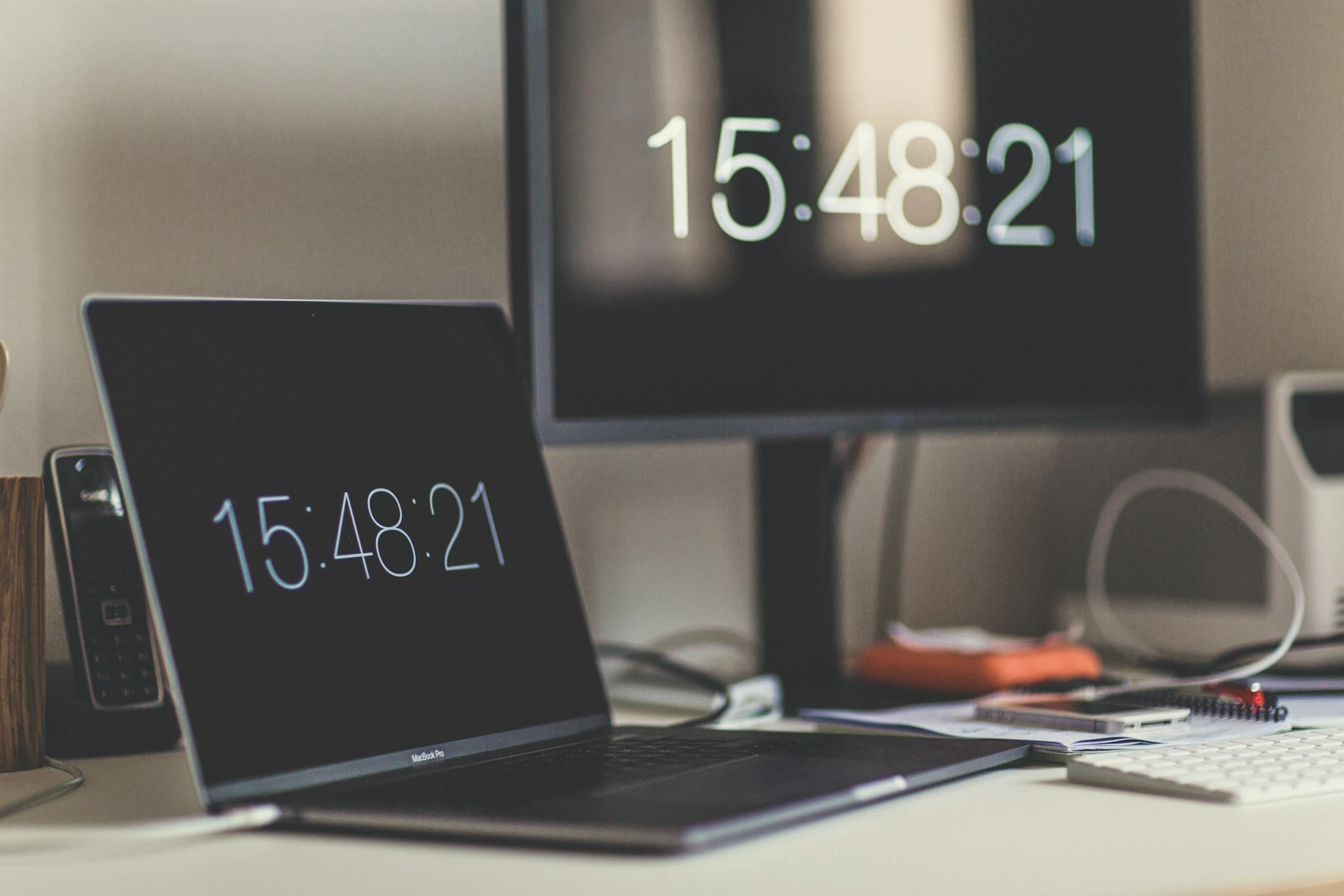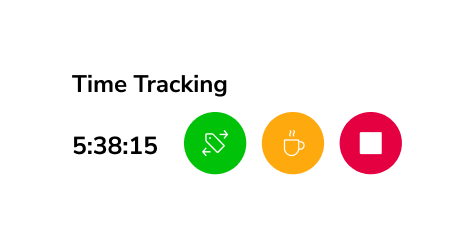How AI Is Transforming Time Tracking
Artificial Intelligence (AI) is changing nearly every aspect of work, and time tracking is no exception.
Traditional manual tracking methods are often prone to errors, require constant input, and can feel like an extra chore for employees. AI is changing that by making time tracking smarter, faster, and more accurate than ever.
It’s crazy to think how fast AI has developed in recent years and even more exciting to imagine how much it’s still set to grow. From automated timesheets to predictive scheduling, AI is no longer just a convenience, it’s becoming a core tool for boosting productivity and leveling up the way we track time.

Photo by Markus Spiske on Unsplash
The Current State of Time Tracking
Time tracking today isn’t built on the usual timesheets and punch clocks you used to see on office walls. Modern businesses have moved to digital time tracking systems and software tools that automate the process and reduce errors.
The rise of hybrid work in recent years has only amplified the need for smarter systems that can automatically adapt to digital workflows and behavior.
Time tracking systems today can now track time with the click of a button, automatically fill out timesheets, track location, manage leave, and even generate detailed reports for payroll and compliance.
It’s definitely a huge step forward from the traditional methods we were once used to. And with the continuous development of AI time tracking, the process has only gotten even more efficient and intelligent.
What Is AI Time Tracking?
When you say AI time tracking, you’re talking about a smarter, more automated way to monitor and manage work hours.
Beyond just time tracking, AI time tracking tools can monitor things like app and website use, and keyboard or mouse movements—in the background. This helps provide more detailed insights by analyzing patterns and inefficiencies in how time is spent, helping improve productivity without the hassle of manual input.
Learn more with our in-depth article on AI time tracking.
How Is AI Being Used to Improve Time Tracking?
AI has played a significant part in automating the time tracking process. Now, you can clock in and out without even having to press anything. Some software even come equipped with facial recognition technology, letting you clock in with just a quick selfie. It’s amazing, really, how efficient the time tracking process is becoming.
Beyond just automation, though, today, AI is analyzing massive amounts of data and generating creative solutions. It can think, make decisions, and solve problems — taking human capability and innovation to an entirely new level.
Here are just some of the ways AI has been improving time tracking:
- Productivity Monitoring: AI-powered tools can automatically track active and idle times, keyboard and mouse activity, and application usage. This gives you better insights into how employees allocate their work hours so you can spot inefficiencies without resorting to invasive micromanagement.
- Performance Analysis: AI doesn’t just let you collect productivity data, it even analyzes them for you. By analyzing workflow patterns, project timelines, and task completion rates, AI can identify bottlenecks, measure output, and even recommend adjustments to improve efficiency.
- Feature Assistance: Working with time tracking systems can be complex, depending on the software you’re using. Navigating through certain features can be hard, but not when you can just ask AI to use a feature for you. You can simply ask an AI assistant to execute tasks for you, such as generating a custom report, setting reminders, or adjusting time entries.
- Mitigating Workplace Burnout: AI can detect signs of burnout or overwork by analyzing trends in work hours and break times. It can pinpoint which team members are consistently working late or skipping breaks, signaling potential stress risks. This allows managers to take proactive steps to ensure a healthier work-life balance.
AI Time Tracking Trends in 2025
As AI-based features become more mainstream, plenty of traditional time-tracking platforms have begun repositioning themselves as AI-powered tools to meet the growing demand for intelligent time tracking solutions.
Here are some core AI-powered capabilities transforming time tracking today:
1. Timesheet Automation
Automation is just one of the many things that AI does well. And while it has been possible long before AI, automation has now become smarter and more adaptive thanks to artificial intelligence.
In the context of time tracking, AI can do more than just log hours. It can predict, detect, and optimize how timesheets are created and approved:
- Predictive Filling – If your team works on the same project every Monday morning, AI can auto-fill those entries for you.
- Anomaly Detection – Forgot to clock out? AI detects inactivity and suggests an accurate end time to prevent errors.
- Smart Approvals – Instead of manually reviewing every timesheet, AI can highlight only the entries that need attention.
This means fewer manual corrections, better compliance, and a lot less guesswork for managers.
Many platforms are already leveraging AI to automate time tracking. The Timely AI tool, for example, runs passively in the background and tracks all the time an employee spends on tasks, without requiring the user to press a button to start the timer. Toggl Track’s auto-track feature, on the other hand, fills timesheet entries with a record of app and browser activity.
2. Productivity Analysis
Measuring productivity is one thing, but generating actionable insights that actually improve it is another. AI can impressively do both.
Take WebWork’s AI time tracking feature, for example. It doesn’t just log hours; it actively monitors work patterns, device usage, and activity levels. By tracking keystrokes, mouse clicks, and platform usage it provides an accurate picture of how time is spent.
But WebWork goes beyond monitoring. Its AI autonomously analyzes workflows, detects inefficiencies, and generates personalized productivity strategies.
Tools like Clockify have also implemented AI to display real-time insights into employee productivity with dashboards. There’s also Timely’s “Memory” AI, which learns from historical patterns, improving over time.
Jibble is also stepping into AI-driven productivity optimization by developing advanced features to monitor keyboard and mouse activity, along with app and website usage. The goal? To identify inefficiencies and give managers deeper insights into work habits.
3. Work-Life Balance Monitoring
It is difficult to know from the surface if someone on your team is at risk of burnout.
According to a report from Forbes on job burnout in 2025, job burnout has significantly increased this year.
With AI, identifying burnout risks becomes easier and more accurate. By analyzing work hours, overtime trends, and activity patterns, AI can quickly flag employees who may be overworked. Some platforms even allow you to ask simple questions like:
- “Who’s been working the most this month?”
- “Who’s consistently online after hours?”
- “Who’s underutilized and can take on more tasks?”
These insights help managers redistribute workloads, encourage proper breaks, and maintain a healthy work-life balance.
4. Intelligent Assistance
Need a report, a performance evaluation, or send out event emails? No, you don’t need an assistant to do it for you anymore. You can use AI!
Time tracking tools now come equipped with AI-driven assistants that can generate detailed reports, create summaries, and even draft performance evaluations in seconds.
These reports are based on the time data you already have on the app so it’s always up-to-date and relevant.
Some time tracking platforms even let you ask the assistant questions like “Who worked the most overtime this week?” or “What were the productivity trends from last month?”, and get instant answers.
Beyond that, AI can automate recurring tasks like scheduling, sending reminders, and even predicting future workload trends.
What are the Benefits of AI Time Tracking?
Why even bother with AI? Well, it’s simply because if you don’t leverage AI, you’re going to fall far behind those who do.
There are so many benefits that comes with using AI for time tracking, here are just some of them:
Increased Accuracy
With a more hands-off approach to time tracking, AI eliminates human error created with manual time entries, creating more consistent, reliable tracked data. This also reduces the threat of time theft and ensures that employees are fairly compensated for their work.
Better Employee Experience
No more forgetting to clock in, no more guesswork. AI features like automated reminders, predictive entries, and facial recognition make time tracking quick and stress-free for everyone.
Reduced Admin Overhead
Every minute you save on admin is a minute you can reinvest in higher-value work. This is why AI can be so valuable. It can handle repetitive tasks like filling timesheets, approving hours, and generating reports, freeing up managers and HR from tedious manual processes.
Enhance Security and Fraud Detection
With AI time tracking, the system can automatically flag suspicious time logs, like skipped breaks or unrealistic work hours, reducing the risk of timesheet fraud. It also helps businesses stay compliant with labor laws by ensuring proper break times and maximum work-hour limits are observed.
Limitations of AI Time Tracking
Much like anything, AI time tracking still has its limitations and disadvantages that are important to consider.
Dependency
Depending on how you look at it, AI can lead to overdependency. Relying too heavily on automated processes might cause teams to overlook errors, ignore context, or lose the ability to manage tasks manually when needed. This is why it’s still crucial to maintain a balance between AI and human oversight.
Inaccurate Context
Gauging productivity based solely on recorded activity in a time tracking app isn’t always conclusive. For example, an employee might appear “inactive” because they’re brainstorming, attending a call, or performing tasks offline, activities that don’t involve keystrokes or mouse clicks. This lack of context can lead to unfair performance evaluations, misinterpretation of work patterns, and unnecessary pressure on employees.
Ethics and Legal Risks
The use of AI in the workplace raises important questions about privacy, consent, and data security. Tracking features—especially those involving facial recognition or location data—must comply with labor laws and data protection regulations (like General Data Protection Regulation). Misuse or lack of transparency can lead to serious legal consequences and erode employee trust.
Final Thoughts
The future of work is not just about when we work, but how intelligently we track and optimize that time.
As AI continues to evolve, we can expect time tracking systems to become even more intuitive, anticipating work habits, reducing admin work, and offering real-time insights that empower better decisions.
AI is definitely something to get excited about. By leveraging AI-driven solutions, businesses and individuals alike can focus less on repetitive tasks and more on the meaningful work that drives growth and innovation.
At Jibble, we fully recognize the potential of AI when it comes to time tracking. That’s exactly why we’ve been investing in smart, AI-powered features that make tracking time easier, faster, and more insightful—for teams of any size.
From intelligent timesheet suggestions to real-time productivity insights, we’re constantly working to help businesses get more out of every minute.
Explore our Product Portal to see the latest and what’s coming next.
Related Articles:
How AI-Powered Software is Transforming Workspaces


